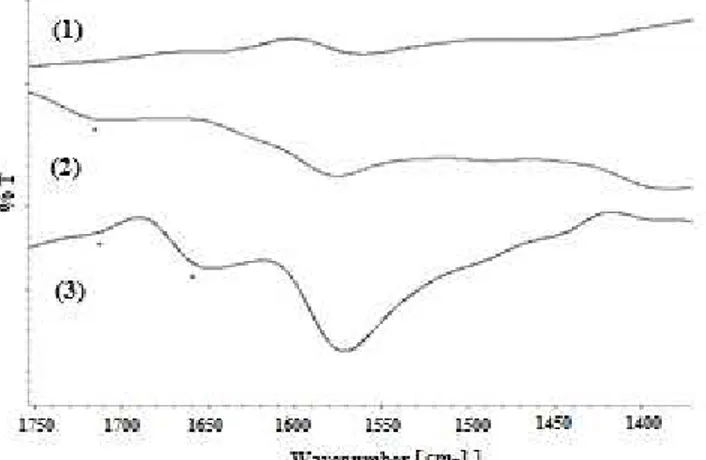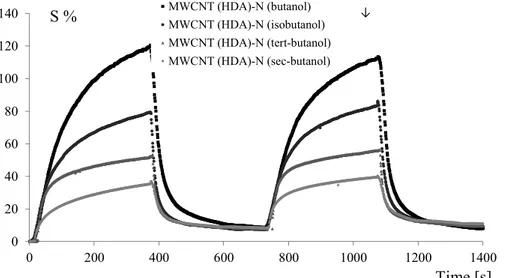See discussions, stats, and author profiles for this publication at: https://www.researchgate.net/publication/260163322
Comparison of vapor sensing properties of pristine and
hexamethylenediamine-treated MWCNT networks to primary, secondary and
tertiary alcohols
Conference Paper · September 2013
CITATIONS 0
READS 42
3 authors:
Some of the authors of this publication are also working on these related projects:
PhD ResearchView project
PVC inorganic hybridsView project Ruhan Benlikaya
Balikesir University
23PUBLICATIONS 180CITATIONS
SEE PROFILE
Petr Slobodian
Tomas Bata University in Zlín
101PUBLICATIONS 705CITATIONS
SEE PROFILE
Michal Machovsky
Tomas Bata University in Zlín
62PUBLICATIONS 360CITATIONS
SEE PROFILE
All content following this page was uploaded by Michal Machovsky on 21 July 2014.
Comparison of vapor sensing properties of pristine and hexamethylene
diamine-treated MWCNT networks to primary, secondary and tertiary
alcohols
Ruhan Benlikaya
1,2,a, Petr Slobodian
1,3,b, Michal Machovsky
1,3,c1
Centre of Polymer Systems, University Institute, Tomas Bata University, Nad Ovcirnou 3685, 760 01 Zlin, Czech Republic
2
Department of Secondary Science and Mathematics Education, Faculty of Necatibey Education, Balikesir University, 10100, Balikesir, Turkey
3
Polymer Centre, Faculty of Technology, Tomas Bata University, T.G.M. 275, 760 01 Zlin, Czech Republic
a
ruhan@balikesir.edu.tr, bslobodian@ft.utb.cz, cmachovsky@ft.utb.cz
Keywords: Carbon nanotube network, CNT, alcohol, gas sensor, functionalization
Abstract. The sensing properties of pristine and hexamethylene diamine (HDA)-treated multiwall
carbon nanotube networks (MWCNT-Ns) to selected primary, secondary (sec-) and tertiary (ter-) alcohols were examined by resistance measurements. It was seen that sensor responses, S (%), of MWCNT (HDA)-N to these alcohols were much higher than those of the pristine network. An increase in the S (%) values per mm Hg of both networks was observed from propanol to butanol, when their values from primary alcohols to sec-/tert-ones decreased due to the change in the interaction area of these alcohols with the MWCNT-Ns.
Introduction
In the last five years there has been a huge increase in the number of published papers related to nanomaterial-based gas or vapor sensors involving also carbon nanotubes [1-6]. One way of improving sensing properties of carbon nanotubes (CNTs) is functionalization of their surface by various methods. Different surface modifications of carbon nanotubes including chemical [1-3] and plasma treatments [4-7] have been reported for enhancing the sensitivity properties of carbon nanotubes to iso-pentane, diethyl ether [2], formaldehyde [3], ethanol [1,4-6], acetone [2,6], methanol [2,6], benzene, toluene [6], nitrogen dioxide and ammonia [7].
In literature there is limited systematic experimental data showing sensing behavior of CNT networks to different members of the same organic compound group such as alcohols, aromatic hydrocarbons, etc., as far as we know. Such data can help us understand the factors influencing vapor sensing properties of CNT networks and prepare a suitable CNT sensor for required gas/vapor. In this study, hexamethylene diamine (HDA) treated multiwall carbon nanotubes, MWCNT (HDA), were prepared via the reaction of HDA with acyl chloride on the surface of the MWCNT obtained by the treatment of thionyl chloride. The sensing properties of pristine and the modified MWCNT networks (Ns) to vapors of primary, secondary (sec-) and tertiary (tert-) alcohols involving propanol, iso-propanol, butanol, sec-butanol, iso-butanol and tert-butanol were examined by resistance measurements.
Experimental
MWCNTs (BAYTUBES C70 P) used in this study were supplied from Bayer Material Science AG, Germany. Preparation of MWCNT (HDA) involves three steps [8] as given below:
Step 1: 0.3 g of pure MWCNT was added to 20 mL of the mixture of H2SO4 and HNO3 (3:1). The
mixture was sonicated in water bath for 2 h and stirred with a mechanical mixer for 15 h at 35oC.
Then it was diluted with distilled water and washed till pH 7.
All rights reserved. No part of contents of this paper may be reproduced or transmitted in any form or by any means without the written permission of TTP, www.ttp.net. (ID: 195.178.92.19-24/03/14,10:50:20)
Step 2 : The mixture of 0.3 g of MWCNT (HNO3-H2SO4) and 30 mL of SOCl2 was stirred at 80 °C
for 24 h after that the dispersion was decanted and the rest of unreacted SOCl2 was removed under
vacuum.
Step 3 : The obtained product from Step2 was added to the solution of HDA in DMF and dispersed by sonication in a water bath at 35 °C for 30 min. Finally the reaction was conducted at 65-75 °C for 24 h in the presence of triethylamine as a catalyst. The resulting product was then refluxed with acetone and ethanol to remove any residue of HDA.
MWCNT networks were prepared according to the procedure described in the previous study [2]. The time of the sonication was 5 minutes differently from the study. The obtained stripes (length 15 and width 5 mm) were placed on a planar holder with Cu electrodes fixed on both sides of the specimen and their resistances were measured along the specimen length during adsorption and desorption cycles by the two-point technique using multimeter Sefram 7338. The measurements were conducted in saturated vapors at atmospheric pressure and temperature 25°C and repeated three times. Fourier-transform infrared (FTIR) analyses of the MWCNT samples in form of KBr tablets were performed on Thermo Scientific Nicolet IS5 by using ID1 Transmission accessory. The structures of MWCNT networks were analyzed by scanning electron microscope (SEM) Vega LMU, produced by Tescan Ltd.
Results
Characterization of MWCNT (HDA)
FTIR spectra of MWCNT, MWCNT (HNO3-H2SO4) and MWCNT (HDA) in Fig. 1 show that
the carbonyl stretch at 1716 cm-1, of carboxylic acid groups on the surface of MWCNT (HNO3
-H2SO4), shifts to about 1650 cm-1 in the spectrum of MWCNT (HDA) and there are still unreacted
carboxyl groups on its surface. These findings indicate the conversion of some carboxyl groups to -CONH (amide) groups [8] on MWCNT (HDA).
Fig.1 FTIR spectra of MWCNT (1), MWCNT (HNO3-H2SO4) (2) and MWCNT (HDA) (3).
Fig. 2 SEM images of upper surfaces of MWCNT (pure) (A) and MWCNT (HDA) (B) networks.
Fig. 2 shows SEM images of pristine MWCNT and MWCNT (HDA) networks which have smooth and rough surfaces, respectively.
Resistance Measurements
Stripes made of the MWCNT-Ns were cyclically exposed to saturated vapors of the alcohols in this study at intervals of 6 min. During this time the adsorption of organic molecules causes the increase in resistance of MWCNT-Ns with time. Gas response or sensitivity (S) is defined as in Eq. (1): a a a g R R R R R S= − =∆ (1)
where Ra represents specimen resistance in air and Rg resistance of the specimen exposed to
gas/vapor, ∆R stands for the resistance change. Fig. 3 shows S (%) values of MWCNT (HDA)-N to positional isomers of butanol for two cycles of adsorption /desorption as an example.
Fig. 3 S (%) values of MWCNT (HDA)-N exposed to the saturated vapors of position isomers of butanol at 25°C for two cycles.
Fig. 4 S (%) values per mm Hg for MWCNT and MWCNT (HDA) networks measured for primary, secondary and tertiary alcohol vapors.
0 20 40 60 80 100 120 140 0 200 400 600 800 1000 1200 1400 MWCNT (HDA)-N (butanol) MWCNT (HDA)-N (isobutanol) MWCNT (HDA)-N (tert-butanol) MWCNT (HDA)-N (sec-butanol) Time [s] 0 2 4 6 8 10 12 14 16
Propanol Isopropanol Butanol Isobutanol Sec-butanol Tert-butanol MWCNT (HDA)-N MWCNT-N
S % ↓
Fig. 4 shows S (%) values per mm Hg of MWCNT and MWCNT (HDA) networks to the primary, secondary and tertiary alcohol vapors. An increase in these values of both networks was observed from propanol to butanol, when they had a decrease in their values from primary alcohols to sec-/tert-alcohols. The reason of the decrease could be that straight chain molecules interact with the surface of carbon nanotubes more effectively than branched chain molecules and therefore larger interaction area occur between them. This can lead to more increase in the intrinsic and contact resistance of CNTs. It was found in other study related to adsorption kinetics of alcohols on CNTs that linear alcohols bind more strongly on single wall carbon nanotubes than branched alcohols [9]. However, the difference among S (%)/mm Hg values belonging to these alcohols is more evident for MWCNT (HDA) and its sensor response values are much higher than those of pure MWCNT, which can be associated with higher inter molecular interactions (hydrogen bonding and London interactions) between alcohols and MWCNT (HDA)-N.
Summary
In this study, the network of hexamethylene diamine treated multiwall carbon nanotubes, MWCNT (HDA), were prepared by using chemical and vacuum filtration methods, respectively. Its vapor sensing properties determined by resistance measurements to selected primary, secondary and tertiary alcohols were compared with those of pure MWCNT-N. The S (%) values per mm Hg of both MWCNT-Ns to these alcohol vapors decreased as primary>secondary>tertiary. However, it is better to use MWCNT (HDA)-N for determining the positional isomers of propanol and butanol than the pristine network due to its higher sensitivity responses to the alcohols and clear differences among the responses.
Acknowledgement
The work was supported by the Operational Program of Research and Development for Innovations co-funded by the European Regional Development Fund (ERDF), the National Budget of the Czech Republic within the framework of the Centre of Polymer Systems project (Reg. No.: CZ.1.05/2.1.00/03.0111) and Operational Program Education for Competitiveness co-funded by the European Social Fund (ESF) and national budget of Czech Republic, within the framework of project Advanced Theoretical and Experimental Studies of Polymer Systems (reg. number: CZ.1.07/2.3.00/20.0104).
References
[1 ] Y. Zhao, W. Li, Microelectron. Eng. Vol. 87 (2010) p. 576.
[2 ] P. Slobodian, P. Riha, A. Lengalova, P. Svoboda, P. Saha, Carbon Vol. 49 (2011) p. 2499. [3] H. Xie, C. Sheng, X. Chen, X. Wang, Z. Li, J. Zhou, Sensor Actuat. B-Chem. Vol. 168 (2012) p.34.
[4] C.K. Liu, M.W. Huang, J.M. Wu, H. C. Shih, Diam. Relat. Mater. Vol. 19 (2010) p. 981. [5] C.K. Liu, J.M. Wu, H.C. Shih, Sensor Actuat. B-Chem. Vol. 150 (2010) p. 641.
[6] I. Hafaiedh, W. Elleuch, P. Clement, E. Llobet, A. Abdelghani, Sensor Actuat. B-Chem. Vol. 182, (2013), p. 344.
[7] R. Ionescu, E.H. Espinosa, E. Sotter, E. Llobet, X. Vilanova, X. Correig, A. Felten, C. Bittencourt, G. Van Lier, J.C. Charlier, J.J. Pireaux, Sensor Actuat. B-Chem. Vol. 113 (2006) p. 36. [8] J. Li, W.D. He, L.P. Yang, X.L. Sun, Q. Hua, Polymer Vol. 48 (2007) p. 4352.
[9] J. Goering, E. Kadossov, U. Burghaus, J. Phys. Chem. C. Vol. 112 (2008) p.10114.
242 Materials and Applications for Sensors and Transducers III
View publication stats View publication stats

